Posts Tagged ‘Significant Tree’
Saturday, April 6th, 2013
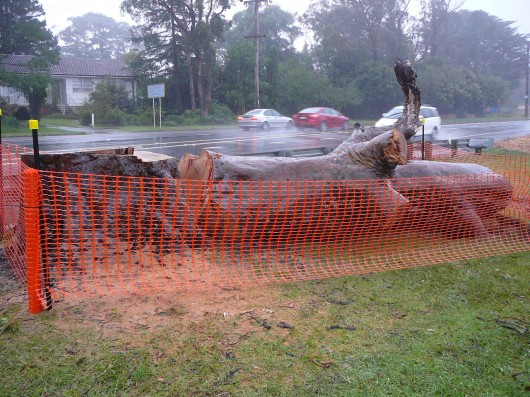 The trunk of a healthy 300+ year old Angophora lies beside the highway in Bullaburra
Blue Mountains, New South Wales, Australia
[Photo by our investigator, 20130403, Photo © ^Creative Commons] The trunk of a healthy 300+ year old Angophora lies beside the highway in Bullaburra
Blue Mountains, New South Wales, Australia
[Photo by our investigator, 20130403, Photo © ^Creative Commons]
.
Government destruction of Bullaburra has begun. Last Monday, April Fools Day 2013, they came and killed Bullaburra’s magificent Angophora to make way for a trucking expressway through the village. But who are the fools who destroy our native heritage?
To many perhaps this is just another tree. Some people value trees and ecology. Others have deep value for wildlife and other animals, especially their pets. Many people value where they live and grow very attached to where they live for reasons that can seem difficult for others to appreciate. But it is the existence rights of species that humans ignore besides their own self-serving interests. Male Baby Boomers remain the most extreme in their self-righteousness, and those in government prescribe utilitarian dictates over the rights of the few.
Elie Wiesel, novelist, political activist, and Humanities Professor at Boston University, has said that the opposite of love is not hate, it’s indifference. The opposite of beauty is not ugliness, it’s indifference. The opposite of faith is not heresy, it’s indifference. And the opposite of life is not death, but indifference between life and death.
.
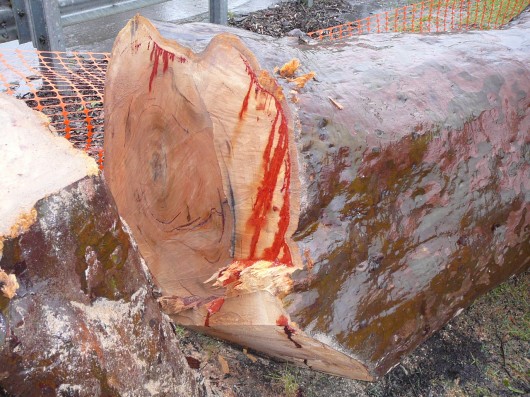 Witnessing an old friend being slaughtered
[Photo by our investigator, 20130403, Photo © ^Creative Commons] Witnessing an old friend being slaughtered
[Photo by our investigator, 20130403, Photo © ^Creative Commons]
.
A native tree that once was part of an Angophora (Sydney Redgum) forest, existed way back when the three explorers Lawson, Wenthworth and Blaxland crossed the Blue Mountains in 1813. They would have passed right past this tree. Two years later road builder William Cox similarly would have laid his rough track, and in 1836 Major Mitchell upgrading the road too would have passed by this tree. For nearly two centuries travellers have passed by this tree, most probably not even giving it a glance. Now it is gone and the opportunity to respect and appreciate this remnant of natural heritage has gone with it.
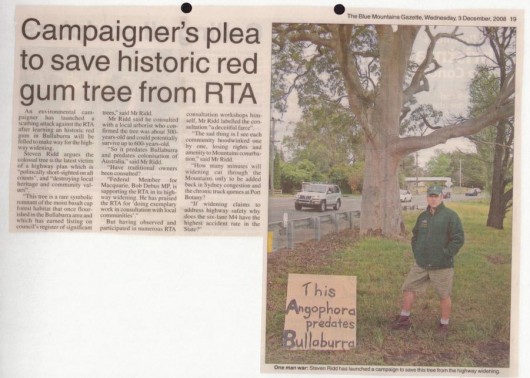 We tried to save you
Campaign to Save Bullaburra’s 300 year old Angophora back in 2008
(Blue Mountains Gazette, 20081203) We tried to save you
Campaign to Save Bullaburra’s 300 year old Angophora back in 2008
(Blue Mountains Gazette, 20081203)
.
Last January, spiteful people set fire to two Hermmansburg ghost gums made famous in Albert Namatjira’s landscape paintings. In 2006, Barcaldine’s famous ghost gum, ‘the tree of knowledge’ was poisoned. Just last week an old gum tree in the Rylstone public school was poisoned. Human hate for native trees has pervaded Australian colonising society since Cook landed at Camp Cove and chopped down trees for firewood.
.
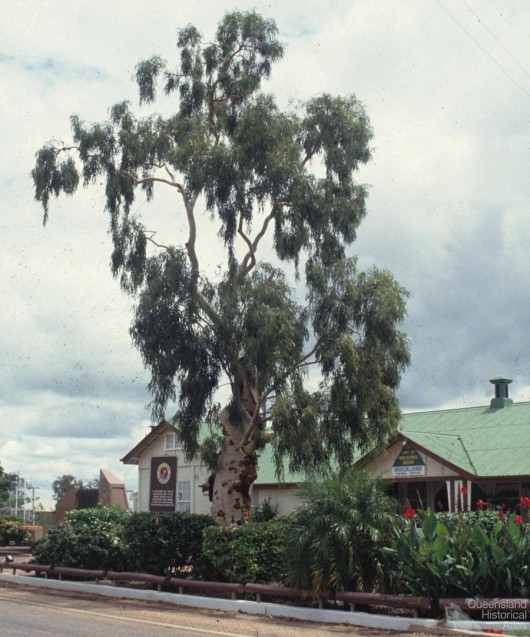 Tree of Knowledge, Barcaldine, Queensland
As it used to be, before it was poisioned.
[Source: Queensland Historical Atlas, 1991,
^http://www.qhatlas.com.au/photograph/tree-knowledge-barcaldine-1991] Tree of Knowledge, Barcaldine, Queensland
As it used to be, before it was poisioned.
[Source: Queensland Historical Atlas, 1991,
^http://www.qhatlas.com.au/photograph/tree-knowledge-barcaldine-1991]
.
A local arborist with expertise in native trees of the Blue Mountains including Angophoras, estimated in 2007 that the Bullaburra Angophora to have been over 300 years old. It was still healthy and still growing as confirmed by the solid core of the severed trunk.
Now it lies like a dead harpooned whale like roadkill beside the highway, where it has stood all those decades.
.
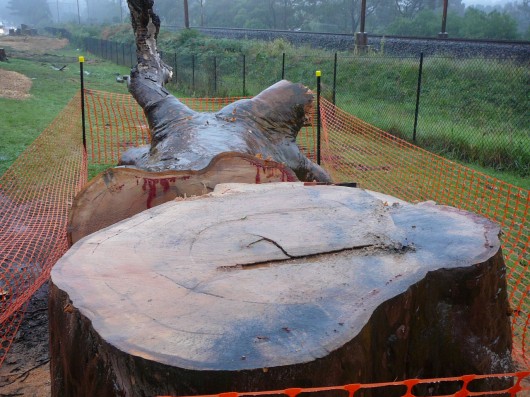 A dendrochronology of more than 300 annual growth rings.
The tree was healthy to the core. It was not rotting. It was not diseased.
It was just in the way of someone’s trucking interpretation of ‘progress’.
[Photo by our investigator, 20130403, Photo © ^Creative Commons] A dendrochronology of more than 300 annual growth rings.
The tree was healthy to the core. It was not rotting. It was not diseased.
It was just in the way of someone’s trucking interpretation of ‘progress’.
[Photo by our investigator, 20130403, Photo © ^Creative Commons]
.
Significant Tree #29
.
This Angophora was recognised as a ‘Significant Tree‘ on the local Blue Mountains Council’s Significant Tree Register back on 17th July 1985 and formally adopted on 21st June 1988, at the time of Australia’s Bicentennary.
No opposition against killing the tree was communicated by the Blue Mountains Council to the RTA-come-RMS. Indeed, this is one of many such ‘significant trees’ that have been killed for development convenience in recent years. Clearly, the Blue Mountains Council’s Significant Tree Register has become disingenuous and lying greenwash.
.
.
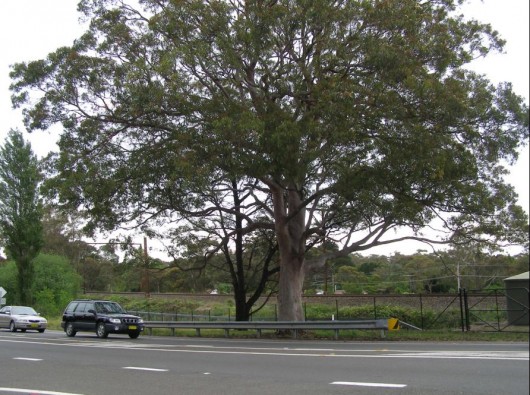 Bullaburra’s Angophora, in memoriam Bullaburra’s Angophora, in memoriam
Registered Significant Tree #: 29
Botanical Name: Angophora costata (Smooth Barked Apple, Red Gum)
Location: Great Western Highway Bullaburra, Opp. Lot 173, DP13407
[Photo by Editor, 20071028, Photo © ^Creative Commons]
.
Trucking Expressway
.
The death of the Angophora is the begining of the end of Bullaburra. The highway village is set to become a siding for four-laned trucking expressway so that B-double trucks can rumble 24/7 through Blue Mountains towns and villages, nudging 90kph on cruise control.
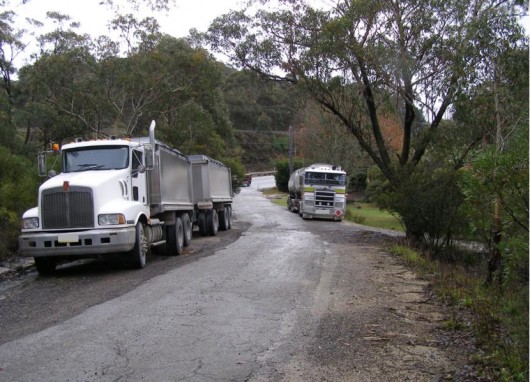 Bigger Trucks demanding bigger roads
[Photo by Editor, 20090531, Photo © ^Creative Commons] Bigger Trucks demanding bigger roads
[Photo by Editor, 20090531, Photo © ^Creative Commons]
.
The rural amenity of this highway village is to be lobotomised into a mono-design urban landscape taking on the same monotonous blandness as any other expressway in the country. The government euphemises this as:
.
“to achieve greater consistency in the design of the Blue Mountains area to achieve a simple and unified design of the highway and its elements.”
.
The fundamental basis for the government’s conversion of this regional highway into a national trucking expressway route is simply “to improve travel times” for trucks, so that more and larger trucks are encouraged to use the route.
The Bullaburrra section is to cost taxpayers $80 million and will see 3.6 hectares of native bushland destroyed on the basis that the vegetation “is already dissected and fragmented“. So it seems that moral relativism allows for wedge development just like a little bit of corruption doesn’t hurt anyone.
But as if the twisted morality isn’t bad enough. It is the greenwashing that really twists the knife in. The RTA-come-RMS in its Review of Environmental Effects maintains that the expressway development aims:
“to protect the natural systems and ecology of the corridor”
..
[Source: ‘The Great Western Highway Upgrade – Bullaburra East, Review of Environmental Effects’, Vol.2, July 2009, Roads and Traffic Authority, New South Wales Government, p.2.]
.
However, the expressway development will simply result in the heart of rural Bullaburra being ripped out and the amenity reduced to a trucking siding adopting a benale concrete landscape akin to the bland urban character of an upper Blaxland, and mirroring what has happened to nearby lobotomised Lawson.
.
“It’s just really tragic after all the horrors of the last 1,000 years we can’t leave behind something as primitive as government sponsored execution.”
~ Wisconsin Senator Russ Feingold, when introducing a bill that would end the death penalty on the Federal level.
.
Progress of Hate
.
Under Australia’s Federal Auslink Policy the national freight thinking is road-centric and all about replacing real trains with road trains. Behind this trucking expressway scheme is a powerful and influential trucking lobby group who donate generously to the political parties that control the New South Wales Government, and various politicians including retired Blue Mountains MP Bob Debus, who has long been a driver of this trucking expressway.
The New South Wales Government department behind this scheme is the RTA-come-RMS (Roads and Maritime Services). In 2007, the then General Manager – Environmental Branch, Ms Erica Adamson, claimed that to retain the Angophora consequential loss of tree roots and pruning would instigate the decline of the tree. “For road construction and safety reasons the tree will have to be removed…to maintain sight lines (for speeding trucks).”
“It’s called progress” they say. For the Blue Mountains it is being inflicted at any cost – economic, social, environmental.
The idea of ‘progress‘ is an economic one that was borne out of Western 18th Century hard-nosed Industrial Revolution and perhaps extending back to the 16th Century Enlightenment of Europe and perhaps even back to when the Iron Age triumphed so aggressively and effectively over the Bronze Age.
Perhaps progress remains subjective only with the progressor who doggedly in his pursuit rough shods over others in the process. Perhaps the idea of progress is a myth. Is the human condition better off as a result? Are we advancing as a society by rough shodding over others and over what is left of Ecology and Nature? The philosophy of ‘^Deep Ecology‘ posits otherwise.
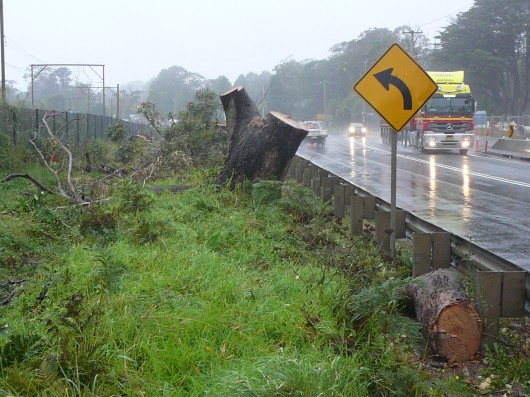 Progress of Hate
[Photo by our investigator, 20130403, Photo © ^Creative Commons] Progress of Hate
[Photo by our investigator, 20130403, Photo © ^Creative Commons]
.
“Progress means getting nearer to the place you want to be. And if you have taken a wrong turning, then to go forward does not get you any nearer. If you are on the wrong road, progress means doing an about-turn and walking back to the right road; and in that case the man who turns back soonest is the most progressive man.”
~ C.S. Lewis, Mere Christianity
.
Related reading on this website:
.
[1] >Threats from Road Making – articles
.
[2] >Bushphobia – a case of deluded convenience
.
Tags: Blue Mountains, Blue Mountains Council, BMCC, Bullaburra, Bullaburra Angophora, Bullaburra's Angophora, ghost gums, Great Western Highway, greenwash, RMS, Roads and Maritime Services, RTA, RTA-come-RMS, Significant Tree, Significant Tree Register, Tree of Knowledge, trucking expressway
Posted in Blue Mountains (AU), Threats from Greenwashing, Threats from Road Making | 1 Comment »
Add this post to Del.icio.us - Digg
Tuesday, January 3rd, 2012
[The following article was initially published as a letter in the local Blue Mountains Gazette (BMG) newspaper on page 4 by this Editor 20081008 under the title ‘RTA Juggernaut‘. It was sparked by reading two separate letters in the paper from Bullaburra residents angry with the RTA and the highway widening process. Copies of those letters are at the end of this article – one by long time Bullaburra resident Viki Wright Rivett; the other by lifetime Bullaburra resident and local historian Una King.]
.
Note: RTA = New South Wales Roads and Traffic Authority; GWH = Great Western Highway
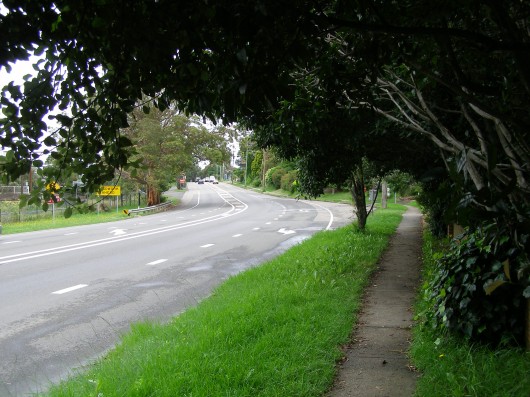 Bullaburra’s rural amenity
Looking east along Great Western Highway towards Railway Station (left)
(Photo by Editor 20110115, free in public domain, click photo to enlarge) Bullaburra’s rural amenity
Looking east along Great Western Highway towards Railway Station (left)
(Photo by Editor 20110115, free in public domain, click photo to enlarge)
.
Decades of complacency and naivety, or do residents of bucolic Bullaburra simply deserve rights to quiet enjoyment and their buena vista? The RTA highway juggernaut is at the door. It won’t just ‘bisect’ the community [‘Anger at RTA‘ BMG 1-10-08]; it will permanently segregate it, raze its rural amenity and degrade it into a noisy truck side stop. Bullaburra is set to receive the same utility vision imposed on Blaxland and so many other Mountains communities.
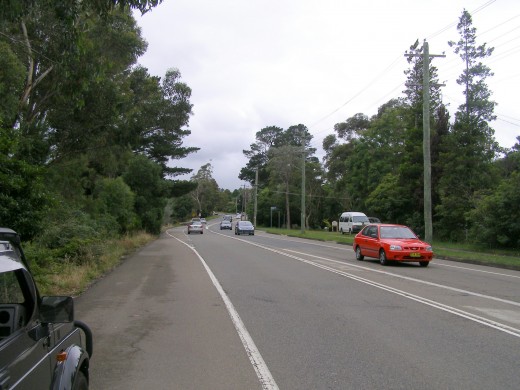 Bullaburra looking east along Great Western Highway towards Noble Street (far centre)
(Photo by Editor 20110115, free in public domain, click photo to enlarge) Bullaburra looking east along Great Western Highway towards Noble Street (far centre)
(Photo by Editor 20110115, free in public domain, click photo to enlarge)
.
I too attended the August township meeting at Bullaburra’s Progress Association hall, not as a Bullaburra resident, nonetheless as a Mountains resident. At the packed meeting, Bullaburrans unanimously endorsed an alternative plan asking the RTA to accommodate local linkages across what will become another four-lane barrier dividing a local community. Personal experience in dealing with the RTA at Leura, Medlow Bath and Katoomba affirms it doesn’t listen or care. It has just plundered the rare 1820s convict road at Leura, hardly pausing its schedule.
 Bullaburra: “Blue Skies” Village – reads the sign (Aboriginal translation)
Western approach to Bullaburra along the Great Western Highway
(Photo by Editor 20110115, free in public domain, click photo to enlarge)
Bullaburra: “Blue Skies” Village – reads the sign (Aboriginal translation)
Western approach to Bullaburra along the Great Western Highway
(Photo by Editor 20110115, free in public domain, click photo to enlarge)
.
The RTA’s massive budget is only limited by political will. It stands to be key recipient of the new Building Australia Fund of $22,000,000,000 then claims it can’t afford community bridges. Be clear, the RTA’s mandate for ‘progress’ is to build more expressways. Driven by road lobbyists, the RTA is extending greater Sydney’s swelling suburbia like Roman legions extended empire.
‘Few understand how much transport influences land use patterns. Transport leads land use. Once an expressway or railway is built, it is easy to change the zoning and development laws to increase the population along the corridor.’ [Then NSW Minister for Planning, Frank Sartor, SMH 29-9-08, p11].
RTA performance is measured by it maximising road ‘ride quality’ and minimising ‘travel times.’ The RTA juggernaut will remain unstoppable so long as local townships rely upon single-handed last ditch battles. Our freshly elected Mountains councillors should stand up for the people of Bullaburra.
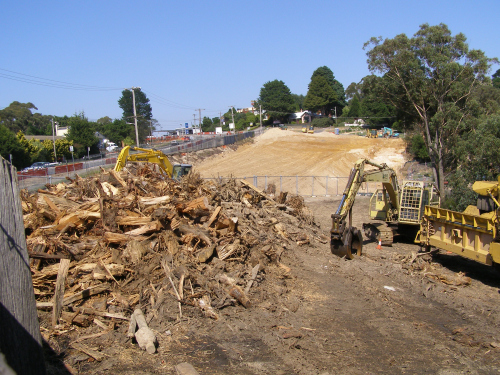 This is what awaits Bullaburra – destruction of rural amenity This is what awaits Bullaburra – destruction of rural amenity
Clearfelled mature native trees at Katoomba to make way for a wider faster trucking expressway
Same project, different section.
(Photo by Editor 20090501, free in public domain)
.
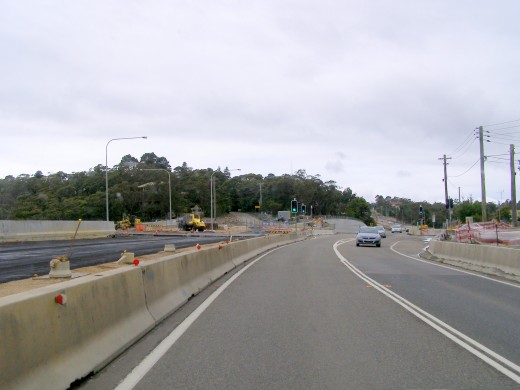 More of what awaits Bullaburra – a trucking expressway amenity! More of what awaits Bullaburra – a trucking expressway amenity!
Eastern approach to Wentworth Falls near Rest Easy Motel (off photo to right).
(Photo by Editor 20110115, free in public domain, click photo to enlarge).
.
.
Following this letter in the weekly local paper, the next week (20081015) the Chairman of the Bullaburra Township Committee, Mr Will Silk, responded as follows:
.
‘Missed Target’
letter by Will Silk in BMG 20081015
.
‘I really don’t know where the author (BMG 08.Oct.2008) is coming from, but he seems to have parachuted into a campaign in the dark and has missed the landing zone.
Steven, a word, to you and other latecomers who are just now arriving from above to hitch themselves to the Bullaburra bandwagon – take the time to find out more about us partisans and the grounds on which we have to work.
At the recent Bullaburra Town Meeting, if you weren’t so blinkered by your condescending stereotyping of a “bucolic Bullaburra”, with its residents slumbering in selfish “complacency and naivety”, you might have seen, heard and, possibly, learned some things of interest to residents’ right activists, environmentalists and radical democrats.
You correctly observed a packed meeting of Bullaburra residents as they unanimously (re-)endorsed the Bullaburra Township Committee’s (BTC) plan to manage the way in which the GWH goes through Bullaburra, and condemned the RTA’s plan.
But, hey, Steven! Where did the BTC Plan come from? It came from 18 years’ proactive work by Bullaburra residents and their organisations. We saw the RTA “juggernaut” coming a long time ago, and instead of just whingeing, we developed our own plan before the RTA did, and we united behind it!
You failed to see that at the meeting, the BTC Plan (with its three integral foundations of pedestrian trian bridge), service road and North-South Bullaburra road-rail bridge) has the unanimous support of all the community organisations in Bullaburra. You also failed to hear all of the now elected ward councillors give our plan their support. And moreover, you didn’t see the now mayor, Adam Searle, and from the Liberal side, Chris van der Kley both, literally “stand up”, together and not for the first time, to show their support.
Far from being naive and complacent, Bullaburra, and the BTC have already put in the hard yards of “politically correct” struggle; delegations, submissions, lobbying. What you failed to see at the meeting was a community gearing up, giving its representatives a very clear mandate, for the next stage in its struggle for a renewed, people and environmentally-friendly village.
We are not “at a last ditch”. But we are about to go to the barricades. We encourage you and all Blue Mountaineers who care about creating such townships to join us if you wish. But leave the mocking paternalism behind. Seeing the RTA as an “instoppable Juggernaut” is defeatist. It is a sort of jaded fatalism that is itself an impotent form of complacency.’
~ Will Silk, President of the Bullaburra Township Committee.
.
.
Harsh defensive words from Mr Silk.
I chose not to reply to Will Silk’s above letter in the local paper, because to have done so would have only detracted Bullaburra residents from their united focus behind Will Silk to deal with the RTA. The aim of my letter had merely been to awaken fence sitting residents to the realisation of the force and power they were dealing with at the RTA. I had witnessed similar David v Goliath community campaigns along the highway, most notably at adjacent Lawson, each village/town community singularly convinced that their case was special and naively campaigning in isolation against the legal might and finances of the RTA.
So I was happy to withdraw my involvement at the time to avoid potential conflict, yet my protest campaign in the local paper broadly against the Trucking Expressway continued through into 2010.
What Mr Silk didn’t realise was that I had been actively involved in previous community campaigns concerning the RTA highway widening stretching back to 2001 when I first arrived in the Blue Mountains. Previous highway campaigns have included Shell Corner (2001-02), Soldiers Pinch (2001-02), Lawson (2003-09), Leura section 1 (2004-05), Medlow Bath (2005 ), Leura section 2 (2006-08), Katoomba (2006-09), Mount Victoria bypass (2006-08) and Bells Line of Road (2005-07).
What Mr Silk also didn’t realise was that at the time I was contracting as a management accountant with the RTA, with some insight into the mechanisations, agendas and management culture of this very much political organisation. What Mr Silk also didn’t realise was that I had researched the history of Bullburra and learnt about the RTA plans for the highway widening through the town.
The RTA plans are set to divide Bullaburra by a faster four-laned expressway, greatly restricting local access and offering very few design concessions to local residents.
.
.
I didn’t have to wait long for the optimistic Bullaburra community sentiments to sour about the likely success of the BTC’s alternative highway design.
The above letter in the local paper by Mr Silk a Chairman of the Bullaburra Township Committee, saw the following week a media release by the Bullaburra Township Committee, headed up with a photo including Will Silk.
.
‘Bullaburra joins highway battle‘
by Michael Cleggett (journalist), BMG 20081022, p3.
.

‘The RTA’s highway-widening roadshow continues to attract jeers wherever it arrives, and this time it’s Bullaburra residents voicing anger at plans for their stretch of tarmac.
Members of the Bullaburra Township Committee (BTC) are furious their own designs for the upgrade have seemingly been ignored.
BTC president Will Silk is concerned the RTA has not fully accounted for the effect of any works on the village and its people.
After years of campaigning to different levels of government and departments, residents were dismayed by the RTA proposal when it was made public earlier this year.
“We went in to see them in the first week of June this year and not to our surprise, but to our disgust, we found that they didn’t even know about our plan, they hadn’t taken it into consideration,” Mr Silk said.
In anticipation of the highway upgrade the community has been looking into the issue for more than 20 years. The three pillars of the BTC designs are a road bridge connecting north and south Bullaburra, a comprehensive service road on the southern side running parallel to the highway and a pedestrian bridge. None of these form part of the RTA’s proposal.
Mr Silk said the BTC’s vision presents a much better opportunity to create “a modern 21st century village with the unavoidable highway through the middle of it”.
The service road is intended to allow residents to traverse the town without having to make a difficult turn onto the highway while the bridges would avoid permanently dividing the town as well as providing easier emergency vehicle access. This stage of work will expand the highway to two lanes in each direction from Noble Street to 600 metres west of Genevieve Road.
Outside of the widening, the main features of the RTA plans involve relocating the commuter car park to the southern side of the highway, moving the pedestrian crossing lights, an access road for some properties between Genevieve Road and Noble Street and a number of other changes to street access and bus stops.
Member for Blue Mountains Phil Koperberg has expressed a willingness to further examine the issue.
“(The BTC) proposal for a link bridge between north and south of the Great Western Highway obviously has merit,” he said. “However, whether or not it is practical, feasible or constructable I’ll take advice from the RTA.”
An RTA pamphlet delivered to residents suggests that advice will be bad news. It describes a comprehensive access road and a pedestrian overbridge as unfeasible.
A spokesperson for the RTA said an information session earlier this month was well attended with “some worthwhile suggestions . . . put forward, which will be investigated”.
A second information session will be held by the RTA from 10am-1pm at Lawson Bowling Club this Saturday, October 25.’
.
.
This article by the Bullaburra Township Committee was then followed up by Bullaburra resident Patrick Tatam, who clearly had a stronger interpretation of how discussions between locals and the Roads and Traffic Association were proceeding.
.
‘RTA Bullaburra fiasco’
by Patrick Tatam, Bullaburra (letter in BMG 20081029, p4)
.
‘Regarding the obstructionist, bullying attitude of the RTA towards the Bullaburra Township Committee (BTC), attacking the BTC’s proposed alternativeplan for the GWH rod widening through Bullaburra, here’s my take on what locals are saying:
- The major political parties are basically inept, unable to listen to constituents and consumed with retaining/grasping power
- Phil Koperberg (then local Labor MP) has no effectively influential power, says anything to avoid an issue, is “a bit of a show pony”, and has furthered his career utilising the ‘who you know, not what you know’ approach
- The RTA is seen as a mob of bureaucratic bullies, are even more incompetent than their political masters (the Hazelbrook railway bridge fiasco is common knowledge), and are responsible/answerable solely to the faceless bosses located deeply within the termite mound of RTA headquarters.
- RTA representatives at community meetings are aggressive, non-consultative, driven only by their own preferred agendas, ill-prepared, and are the antithesis of ‘public servants’
- Exiting either Boronia or Genevieve Road is currently dangerous, and will become definitely more so with the planned RTA ‘seagull’ intersection, increased speed restrictions (from 70kph to 80kph) and higher traffic volumes (particularly those larger faster trucks).
- The BTC’s plan is a far better solution for the Bullaburra area than the ‘crash through or crash anyway’ RTA proposal; it’s a plan that addresses the needs of the people who live here, not the needs of a termite from a city office, and incorporates beneficial infrastructurec, not just ‘bloody minded’ bitumen.
.
Elected government members, and RTA personnel, should realise that they are our representatives, and that locals are becoming more politically astute, voting more for independents, if only to make our representatives more representative. Those bullies that remain, hiding behind the skirts of party machinery, should recall the destiny of the dinosaur. Or just move to the last bastions of ‘Bullyville’: Zimbabwe, Myanmar, etc.
~Patrick Tatam, Bullaburra.
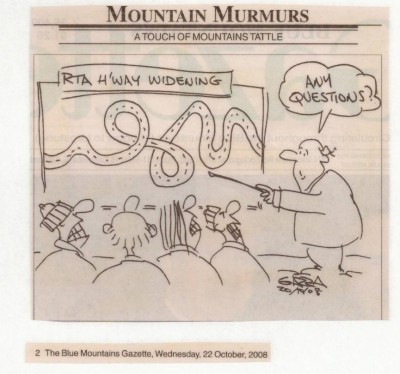
.
.
Editor’s Campaign to Save Bullaburra’s 300+ year old Angophora tree from the RTA
.
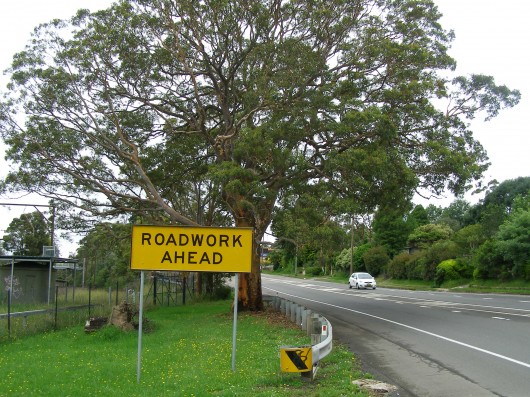 Bullaburra’s Angophora – on RTA’s death row Bullaburra’s Angophora – on RTA’s death row
.
Listed on Blue Mountains Council’s Significant Tree Register
Registered Significant Tree #: 29
Botanical Name: Angophora costata
Common Name: Smooth Barked Apple, Red Gum
Date Registered: 17th July 1985, adopted 21st June 1988
Location: Great Western Highway, Bullaburra, Opp. Lot 173, DP13407.
[Read Significant Tree Register]
.
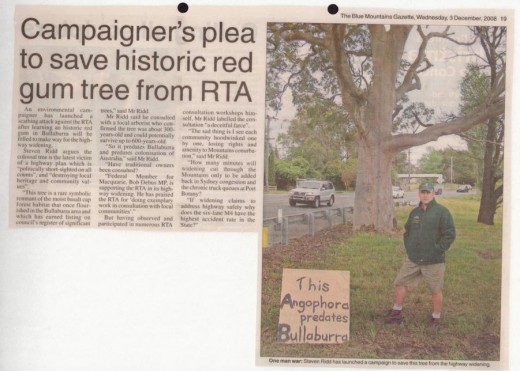 Campaign article in Blue Mountains Gazette 20081203, p19.
.
This followed a quarter page campaign article published in this newpaper on 20081105 costing this Editor $460.
(Click image to enlarge) Campaign article in Blue Mountains Gazette 20081203, p19.
.
This followed a quarter page campaign article published in this newpaper on 20081105 costing this Editor $460.
(Click image to enlarge)
.
.
Letters by Bullaburra residents 20081001
.
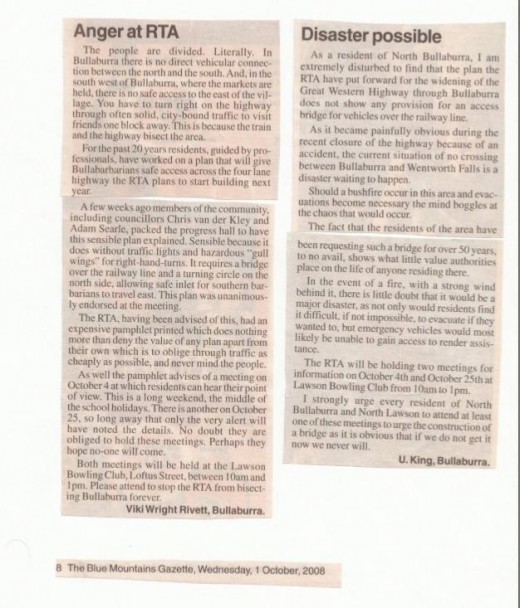 (Click image to enlarge) (Click image to enlarge)
.
Monday, December 12th, 2011
“I wish to explore what remains for most – and has been for me – a terra incognita, a forbidden place, a heart of darkness that civilised people have long attempted to repress – that is, the wilderness within the human soul and without, in that living profusion that envelops all creation.”
.
~ Max Oelschlaeger, The Idea of Wilderness: From Prehistory to the Age of Ecology (1993)
.
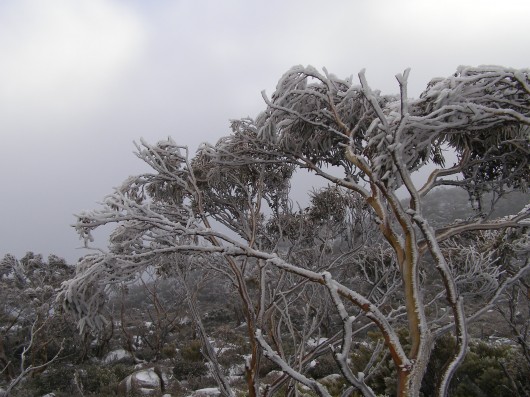 Pinnacle of Mount Wellington, Tasmania
(Photo by Editor 20111001, free in public domain, click photo to enlarge) Pinnacle of Mount Wellington, Tasmania
(Photo by Editor 20111001, free in public domain, click photo to enlarge)
.
In 2007, former United States Vice President Al Gore‘s campaign to educate citizens about global warming was portrayed in an award winning documentary film ‘An Inconvenient Truth‘.
The subject matter, global warming, has indeed become an inconvenient truth because the global scale of the problem is such that the powers that be have so far been finding it difficult to comprehend. They have been told that it demands a response so systemic as to be transformational, which is highly inconvenient for them to say the least. The transformational response is mostly inconvenient to the powerful vested interests in polluting industries that are key contributors to global warming – particularly oil, gas, coal, heavy manufacturing, transport and weapons industries.
.
‘Deluded Convenience’
.
On the flip side of this inconvenience of the truth, powerful vested interests understandably, are hell bent on maintaining their convenient business as usual practices, choosing to ignore, reject and deny the truth. It is their short term interests to do so, because change is expensive and threatens to diminish their power, influence and wealth. But in the long term, by perpetuating practices that are shown to be damaging to the Earth’s climate, the imperative of maintaining a convenient business as usual approach is a deluded one, as everyone will be adversely affected by global warming. They are only deluding themselves. Such harmful business-as-usual practice is a ‘deluded convenience‘.
Harmful business-as-usual practices that are contributing to global warming were once branded aspiringly in the 18th, 19th and 20th Centuries as ‘industrial progress‘. The widespread Western culture from Western Europe and the United States has for over three hundred years idolised the ‘civilised’ advances of the Industrial Revolution, capitalism and economics. Western economies now have many conveniences of lifestyle, but attaining them has caused considerable cost to societies and ecology. Globalisation has destroyed family-based enterprises, local markets and village communities and caused wars and immense suffering. Industrialisation has destroyed many forests, rivers, valleys, coastlines and species. These have been the cost of convenience, the cost of civilisation; and we are now paying the price.
.
“It is fairly widely accepted today that environmental destruction ultimately becomes self-destructive as a sick and impoverished global environment in turn sickens and impoverishes the human members of that ecosystem.
..Why, despite warning signs from a stressed global ecosystem, mounting scientific evidence, and public education campaigns, does degradation of the environment continue to persist and mount?”
.
~ Catherine M. Roach, 2003, ‘Mother Nature: Popular Culture and Environmental Ethics.
.
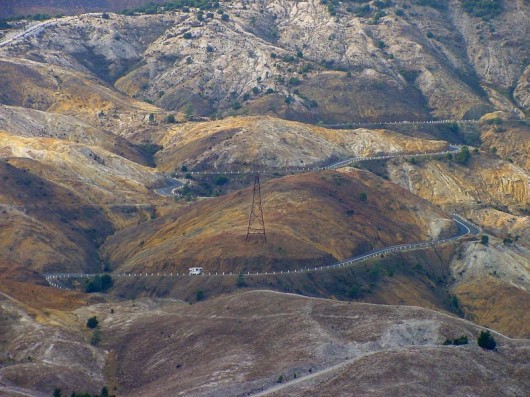 Absolute environmental destruction above Queenstown, Tasmania Absolute environmental destruction above Queenstown, Tasmania
.
Bushphobia – a form of deluded convenience
.
Bushphobia is a composite term emanating from Australia, which combines two words ‘bush’ meaning the native forest and scrub environment of Australia’s unique animals and plants, with the non-clinical use of the term ‘phobia’. Phobia (from Greek φόβος, phóbos: fear, phobia) is an anxiety association, a negative attitudes towards, a dislike, disapproval, prejudice, discrimination, or hostility of, aversion to, or discrimination against something. Bushphobia is borne out of learnt acculturation adopting two distinct attitudes:
- A deep fear of the bush due to its propensity to burn and cause horrific wildfires
- A dislike of Australian native vegetation due to its wild untamed appearance which is so different to exotic trees and landscapes that have a more symmetrical and accessible character
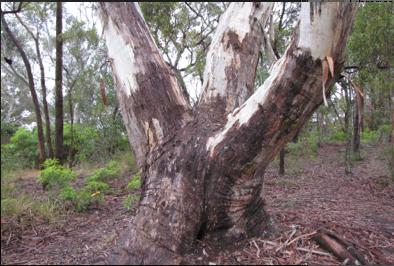 An Australian native tree discriminated against by a pro-development Court ruling…because it may be dangerous
^http://www.savethetree.org/
An Australian native tree discriminated against by a pro-development Court ruling…because it may be dangerous
^http://www.savethetree.org/
In this case a discrimination against the bush, where the word ‘bush’ is an Australian term for native forest and scrubland. Bushphobia was first used with its modern meaning in 2008 in the Blue Mountains in eastern Australia which represents an intolerance and prejudice against the natural Australian bush vegetation mainly because of its susceptibility to burning in the case of bushfires and the consequential fire threat to life and private property.
The combined meaning is to have a persistent irrational fear specific fear or loathing of the natural (bush) environment. There are three classes of phobias: agoraphobia, social phobia, and specific phobia (Wood 521). Bushphobia is a specific phobia associated with a fear of natural environment.
Bushphobia is a socially learnt fear and loathing toward the bush common amongst rural volunteer bushfire fighting organisations which is instilled in new recruits as part of the training tans assimilation process. Bushphobia has thus become a form of learned cultural prejudice amongst the rural fire fighting fraternity throughout Australia. This attitude becomes deep seated and a motive to regard native forests, not as valued natural assets and habitat for native flora and fauna, but only as a combustible fuel that is prone to burn and thus a menace and ‘hazard’. The standard myth conveyed about the bush that inculcates bushphobia is that if the bush is not destroyed and allowed to grow naturally then the bush will develop into an uncontrollable fuel that in the event of a bushfire will cause an horrific fire storm and Armageddon. The issue of inadequate bushfire fighting capabilities is conveniently ignored.
Those who only see the bush through a bushphobic mindset desire to burn it, bulldoze it and destroy it at any opportunity when weather permits such action to be done safely. Deliberate burning of the bush has become a ‘prescribed burning’ policy of Australian governments at both state and federal level attracting massive resources. In New South Wales prescribed burning is labelled ‘hazard reduction’. History however has shown repeatedly that many prescribed burning activities frequently escape control lines an end up destroying vast areas of bush.
.
.
NIMBYism – a celebration of ‘think globally, act locally’
.
The maxim ‘Think globally, act locally‘ has long passed into the vernacular, urging grassroots activism where thinking about the health of the entire planet is translated into taking action at a local level in one’s own community. The phrase has been originally attributed to Scottish town planner and social activist Sir Patrick Geddes FRSE [1854-1932].
 Sir Patrick Geddes (c.1886) Sir Patrick Geddes (c.1886)
.
At a time in the early 20th Century when industrialisation was dramatically altering the conditions of social life, Geddes recognised the role of architectural amenity on urban life, particularly promoting the happiness, health and comfort of all residents, rather than focusing on roads and parks available only to the rich. He applied this in his design of Edinburgh, Tel Aviv and Bombay. Geddes was an advocate of nature conservation and strongly opposed to industrial pollution. Some historians have claimed he was a forerunner of modern Green politics. At a time of rapid urban growth, Geddes coined the term ‘conurbation’ observing how population growth was pushing large towns to merge into one continuous urban and industrially developed area. In Geddes’ 1915 book “Cities in Evolution” his advocacy of maintaining local character in urban planning is clearly evident:
‘Local character’ is thus no mere accidental old-world quaintness, as its mimics think and say. It is attained only in course of adequate grasp and treatment of the whole environment, and in active sympathy with the essential and characteristic life of the place concerned.’
.
Prominent American environmentalist and mountaineer David Brower [1912 – 2000] and founder of Friends of the Earth (FOE) in 1969 is believed to have been the first to applied the phrase ‘think globally, act locally‘ in an environmental context as the slogan for FOE. Application of ‘think globally, act locally‘ maxim in this environmental context has manifest itself most prevalently when grassroots activism erupts as a result of inappropriate land use development threats. Local residents opposing inappropriate development are following the thinking of Geddes by recognising the important value of local amenity to the health and happiness of local residents. Developers are quick to deride the rights of local residents to defend their neighbourhood amenity, labelling them as NIMBY‘s – an acronym for the phrase “Not In My Back Yard“, first coined in 1980 by British writer Emilie Travel Livezey in an article ‘Hazardous Waste‘.
Nimbyism is used typically by proponents of a development to pejoratively describe opposition by neighbouring residents. Nimbyism, however is simply acting locally to protect the values of one’s neighbourhood. Standing by and watching an inappropriate development proceed is an option, but why stand by? Residents who plan to live in a locality for some time and perhaps for the rest of their lives, have a democratic right and a say in what happens to their locality and this includes a say its preserving or changing the locality’s amenity and character. It is about holding strong principles of community governance and valuing the rights of locals to participate in decisions that directly affect them. Local residents are the stakeholders who will have to live permanently with a development and so are most deserving in having a louder voice in development decisions to balance corporate developers and their investors.
Amusing variants of NIMBY are:
- ‘NIMFYE’ = Not In My Front Yard Either
- ‘NIMTOO’ = Not In My Term Of Office [a favourite of politicians]
- ‘NITL’ = Not In This Lifetime
- ‘NOPE’ = Not On Planet Earth
- ‘NOTE’ = Not Over There Either
- ‘GOOMBY’ = Get Out Of My Backyard [Common in new suburbs that encroach on industrial sites or airports]
- ‘NIABY’ = Not in Anyone’s Backyard
- ‘NUMBY’ = Not Under My Backyard (applicable to mining companies)
.
And this Editor’s favourite:
- ‘BANANA’ = Build Absolutely Nothing Anywhere Near Anything
.
.
‘A recent report has found that nearly 80% of U.S. residents oppose any new development in their community. It’s the highest level of opposition recorded in the report’s six-year history, and the first time since 2008 that the amount of opposition has increased.’
.
[Source: ‘As America Ages, NIMBYism Could Increase, by Nate Berg, The Atlantic Cities, 20111017, ^http://www.theatlanticcities.com/politics/2011/10/as-america-ages-nimbyism-could-increase/306/]
Given that Nimyism is a developer term used derogatorily against residents who dare to question and challenge land use development , the counter-language on the side of residents is ‘property rights‘ and ‘planning democracy‘. Many residents out of frustration with the local planning process decide to form an action group. One organisation well experienced in this quest is Sydney-based Save Our Suburbs.
.
Save Our Suburbs
.
‘Save Our Suburbs (NSW) Inc is a non-profit & non-aligned group of residents, originally formed to fight against forced rezoning and over-development of Sydney’s suburbs. It has grown to include communities who are fighting for better planning and regulation on a range of development issues, including major infrastructure projects such as road tunnels. Sydney’s beleaguered residents have been fighting an endless string of localised battles against increased density developments (‘urban consolidation‘) and badly planned developments such as unfiltered tunnel exhaust stacks. We have been fighting local councils about local rezoning and local developments, and state government departments about the lack of regulation and planning. Residents are usually the losers in these local battles. If we want to effectively protect the environment and heritage of our suburbs, we need to take the fight beyond our local areas into the State Government arena. This can only be achieved by organised and united residents. Save Our Suburbs (NSW) Inc has been formed for this very purpose.
.
Fundamental Objectives:
- Return Planning democracy to New South Wales, by allowing true consultation, and giving planning power back to local councils: The people should decide, not a Planning Dictator!
- End big developer donations to political parties: We want planning decisions based on merit, not on money!
- Save our property rights: Provide just compensation for loss of land, income or amenity, and for change of land use.
- End forced urban consolidation- allow sensible land release, with infrastructure funded by the government: Dump the failed planning policies, designed to favour big developers rather than the community.
Read More: ^http://www.sos.org.au/
.
.
Bushphobia – a ‘case’ of deluded convenience
.
‘Our urban footprint is encroaching further and further into bushland. The amount of land used as space for community living is decreasing as urban settlements have sprawled. This is affecting the opportunities we now have to meet and interact as communities. The consequences of urban sprawl include a decline in the supply of affordable housing, increased bushfire risk for individuals and property and increasing impacts on the environment.’
Historically, much of the development in the Blue Mountains has encroached well into bushland with little regard for environmental impact and often without supporting infrastructure, such as sewerage and transport systems. This dispersed, sprawling development pattern along ridgelines has been added to by post war residential development, creating many of the ‘suburbs’, particularly in the lower Blue Mountains. As all available sites for new development dry up it is likely that existing urban areas will come under increasing pressure for redevelopment.’
[Source: Blue Mountains Council, ^http://www.sustainablebluemountains.net.au/imagesDB/resources/Paper14bOurFuture.pdf, p.4]
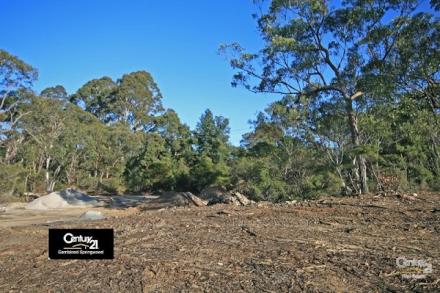 An example of current housing encroachment into bushland
Faulconbridge, Blue Mountains, New South Wales, Australia
An example of current housing encroachment into bushland
Faulconbridge, Blue Mountains, New South Wales, Australia
[Source: Century 21 Real Estate, ^http://www.realestateview.com.au/Real-Estate/faulconbridge/Property-Details-buy-residential-2842241.html
.
A case in point involves the current issue about a significant native tree facing death due to the threat of housing development in the Blue Mountains village of Faulconbridge.
About midway along the conurbated highway corridor through the Central Blue Mountains lies the urban village of Faulconbridge. Like all the other villages and towns along this highway, Faulconbridge residential housing ultimately backs on to the Blue Mountains National Park, which forms part of the Greater Blue Mountains World Heritage Area.
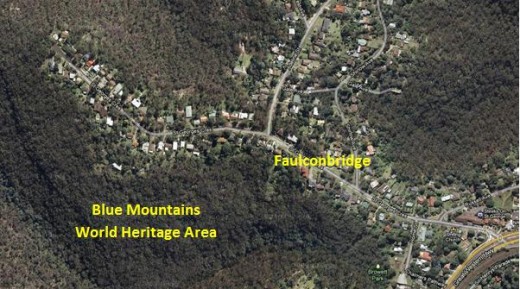 Faulconbridge juxtapositioned to the Blue Mountains World Heritage Area.
[Source: Google Maps]
Faulconbridge juxtapositioned to the Blue Mountains World Heritage Area.
[Source: Google Maps]
.
A local resident action group in St Georges Crescent, Faulconbridge has been recently formed to try to save a significant native tree situated in its natural bush environment from being killed for housing development. The resident group, lead by local Faulconbridge resident Don Cameron, is simply called ‘Save the Tree‘ and a dedicated website has been designed and set up: ^http://savethetree.org
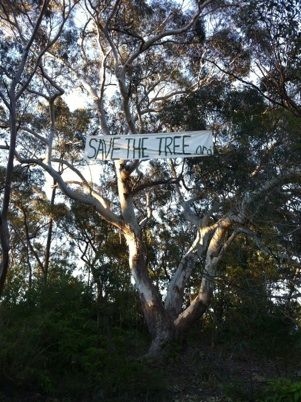 A mature native tree in a forest but on death row
so that property developers can build a house or two.
(St Georges Terrace, Faulconbridge, Blue Mountains, New South Wales Australia,
Source: ^http://savethetree.org)
.
A mature native tree in a forest but on death row
so that property developers can build a house or two.
(St Georges Terrace, Faulconbridge, Blue Mountains, New South Wales Australia,
Source: ^http://savethetree.org)
.
According the website, the subject tree has been listed on Blue Mountains Council’s Register of Significant Trees since August 1985 – #33. The subject land site where the tree stands comprises remnant bushland including the significant tree as well as three locally rare Faulconbridge Mallee Ash trees (Eucalyptus burgessiana), which is a rare species of flora included on the Australian botanical list of Rare or Threatened Plants (ROTAP).
In early 2010, a development application for two dwellings on the site was submitted to council. The proposal included the removal of a considerable amount of the remaining vegetation including the removal of the significant tree. In that same year, numerous residents submitted objections to the development application. As a result of Council’s notification process, fifteen submissions from local residents were received objecting to the development on the following bases:
- Removal of the significant tree from the site
- Clearing and loss of vegetation, including threatened
- Species of vegetation, and screening of the development
- Impacts on streetscape
- The lot should become public land
- Overdevelopment of the site and the bulk and scale of the development
- The proposed development is out of character with the surrounding development
- Proposed subdivision into 2 lots
- Loss of environmental features of the site
- Increased stormwater impacts and local flooding
- Pedestrian and traffic safety
- Reduced building setbacks
.
[Source: Blue Mountains Council, Ordinary Meeting of 28th June 2011, Section: ‘Using Land for Living’, Item 20, Ordinary Meeting, 28.06.11, p.212, 20. 11/85977. Development Application no. X/443/2010 for a detached dual occupancy consisting of a single storey dwelling and a two storey dwelling…Faulconbridge]
.
Council Planning assessed the Environmental Impacts of the proposed development as follows:
‘There are currently three (3) Faulconbridge Mallee Ash (Eucalyptus burgessiana) located on the subject allotment. This is a rare species of flora which is on the list of Rare or Threatened Plants (ROTAP) published by the CSIRO. While it is acknowledged that Eucalyptus burgessiana are a rare plant, they are not listed as a threatened species under either the Threatened Species Conservation Act or the Environmental Protection and Biodiversity Conservation Act.
‘There are also a number of other indigenous trees on the property including a large Eucalyptus Sclerophylla x Eucalyptus Piperita hybrid which is listed as a significant tree in DCP 9 Significant Trees. The proposed development will result in the removal of much of the vegetation on the site including two (2) of the Eucalyptus Burgessianna and the significant tree. The site also contains a number of significant rock outcrops which are identified by the LEP as a significant natural feature.’
.
The proposed development has been sited to avoid as far as practical impacts on those outcrops. In particular, it is noted that the development has been designed to ensure that both the dwellings and the vehicular driveways are predominantly clear of the two most significant features, being the outcrop adjacent the frontage with St Georges Crescent and the outcrop toward the centre of the lot.
Clause 44(4) provides a hierarchy for considering any adverse environmental impact which may result from any development. This clause requires that any development should be designed and sited so as to have no adverse environmental impact. However the clause goes on to provide that where an adverse environmental impact cannot be avoided and no practicable alternative is available, it is necessary to consider the proposed use of the land with reference to the zone objectives of the land. In this respect, while it would be possible to reduce the impacts if the development was confined to a single dwelling only, it is considered that there are no practicable alternatives that would allow all the rare species and the significant tree to be retained and at the same time, allow the permitted use as a detached dual occupancy.
.
It should also be noted that the significant tree has been assessed as not being viable for retention in any case as the result of extensive decay throughout the trunk. This matter is discussed in more detail in the body of the report.’
.
Biodiversity incremental degradation encouraged by Council Planners
.
The matters for consideration are:
‘ The need to prevent adverse impacts on the near pristine conditions of these subcatchments’
.
Council Planning Response:
‘The proposed development is located on an existing vacant lot within the urban area. There will be a significant amount of vegetation removal but this is unavoidable to provide for development of this site. The site will be revegetated and landscaped.’
(Editor: ‘revegetated’ permits destruction of native bushland in favour of creating an exotic urban garden complete with fertiliser and associated runoff).
Both dwellings will be connected to the sewer.
It is considered that the proposed development will not have any adverse impact on the condition of the Grose River Sub-catchment.
(Editor: What is ignored is the collective impact of multiple development applications on Blue Mountains biodiversity and catchments. The planning guidelines fails to factor the collective death by a thousand cuts).
The proposed development is located clear of the areas of surface rock on the property and has been designed to minimise cut and fill by the use of drop edge beams. While the development will result in the removal of two (2) of the Rare or Threatened Plants listed trees, the site is not part of a contiguous area of bushland and it not considered that their removal will have a significant impact on the species.’
– – –
On 28th June 2011, following Blue Mountains Council’s planning assessment, councillors voted unanimously at a General Meeting to refuse the development application on the basis that it breached Council’s local planning laws. The meeting was addressed by: Don Cameron, Robert Leslie, Rama Decent, Terry Barrett.
A motion was moved by Councillors Searle and McLaren that the Development Application No. X/443/2010 be refused on the following grounds:
- The proposed development is contrary to the objectives for the ‘Living-General’ zone under LEP 2005 in that it does not maintain and improve the character of the area, or respond to the environmental characteristics of the site;
- The proposed development, including the removal of the significant majority of existing trees and other vegetation from the site, will have an unacceptable adverse impact on the established landscape character of the locality;
- The proposed development will have an unacceptable adverse environmental impact and is contrary to the provisions of Clause 44 of LEP 2005 in that it has not been designed and sited to minimise impacts on the rare species of plant Eucalyptus Burgessiana and the destruction of rock outcrops on the property;
- The proposed two storey component of the development will be visually prominent and have an unacceptable impact on the existing streetscape when viewed from St Georges Crescent;
- The proposed development is an over development of the site in terms of the height, bulk and scale of the two storey dwelling fronting St Georges Crescent;
- The proposed development does not comply with Clause 2, Part 1, Schedule 2 – Locality Management within the Living Zones, of LEP 2005 by reason that the rear dwelling encroaches onto the 4 metre secondary street frontage setback to Adeline street, and the Council is not satisfied that the objection lodged pursuant to State Environmental Planning Policy No 1 is well founded or that compliance with the standard is unreasonable or unnecessary in the circumstances;
- The proposed stormwater management measures proposed are not adequate, given the potential run-off from the proposed development of the land as a dual occupancy; and Confirmed Minutes Ordinary Meeting 28 June 2011, p.21 of 28
- The grant of development consent will be contrary to the public interest.
.
Upon being put to the Council meeting, the motion was carried unanimously.
Not content with this unanimous decision, the owners of the site appealed against the Council democratic umpire, and in September 2011 the appeal case was heard by The Land & Environment Court of New South Wales.
Specialist arborists gave conflicting reports on the health and viability of the said tree, perhaps according to their respective client motivations. Yet the arborists of opposing parties were engaged as expert witnesses of the Court and so legally presumed to be independent. But legal presumption conveniently ignores contractual undertaking, so the evidence was likely biased to the respective parties.
In the interim findings, the Acting Senior Commissioner agreed that the tree could be removed, notwithstanding its status as a Significant Tree. (Editor: for whose convenience?)
A final ruling on the case will be made after the applicants have submitted a complying landscape plan. One won’t be surprised if the ultimate outcome is from dense mature intact bush to a clearfelled, bulldozed site, and the Court will somehow justify this in favour of the property owners as it normally does.
More information and analysis on this case will be presented in future.
.
.
Further Reading:
.
[1] ‘ The Idea of Wilderness: From Prehistory to the Age of Ecology’, by Max Oelschlaeger, ^ http://yalepress.yale.edu/book.asp?isbn=9780300053708
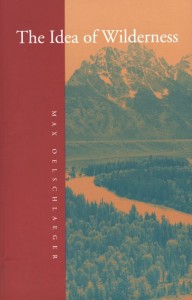 ‘How has the concept of wild nature changed over the millennia? And what have been the environmental consequences? In this broad-ranging book Max Oelschlaeger argues that the idea of wilderness has reflected the evolving character of human existence from Paleolithic times to the present day. An intellectual history, it draws together evidence from philosophy, anthropology, theology, literature, ecology, cultural geography, and archaeology to provide a new scientifically and philosophically informed understanding of humankind’s relationship to nature. ‘How has the concept of wild nature changed over the millennia? And what have been the environmental consequences? In this broad-ranging book Max Oelschlaeger argues that the idea of wilderness has reflected the evolving character of human existence from Paleolithic times to the present day. An intellectual history, it draws together evidence from philosophy, anthropology, theology, literature, ecology, cultural geography, and archaeology to provide a new scientifically and philosophically informed understanding of humankind’s relationship to nature.
Oelschlaeger begins by examining the culture of prehistoric hunter-gatherers, whose totems symbolized the idea of organic unity between humankind and wild nature, and idea that the author believes is essential to any attempt to define human potential. He next traces how the transformation of these hunter-gatherers into farmers led to a new awareness of distinctions between humankind and nature, and how Hellenism and Judeo-Christianity later introduced the unprecedented concept that nature was valueless until humanized. Oelschlaeger discusses the concept of wilderness in relation to the rise of classical science and modernism, and shows that opposition to “modernism” arose almost immediately from scientific, literary, and philosophical communities. He provides new and, in some cases, revisionist studies of the seminal American figures Thoreau, Muir, and Leopold, and he gives fresh readings of America’s two prodigious wilderness poets Robinson Jeffers and Gary Snyder. He concludes with a searching look at the relationship of evolutionary thought to our postmodern effort to reconceptualize ourselves as civilized beings who remain, in some ways, natural animals.’
.
[2] Save Our Suburbs, ^ http://www.sos.org.au/
.
[3] Save The Tree, ^ http://savethetree.org
.
Tags: act locally, an inconvenient truth, Blue Mountains, Blue Mountains City Council, bushphobia, civilisation, conurbation, David Brower, deluded inconvenience, Emilie Travel Livezey, environmental destruction, Eucalyptus burgessiana, Eucalyptus sclerophylla, Faulconbridge, Faulconbridge Mallee Ash, FOE, Friends of the Earth, globalisation, Greater Blue Mountains World Heritage Area, Grose River Sub-catchment, housing encroachment, industrial progress, industrialisation, local character, local residents, Mother Nature, Mount Wellington, NIMBYism, Not In My Backyard, Queenstown, Rare or Threatened Plants (ROTAP), revegetated, rights of locals, Save Our Suburbs, savethetree.org, Significant Tree, Sir Patrick Geddes, Tasmania, terra incognita, The Land & Environment Court of New South Wales, think globally, urban consolidation, wilderness
Posted in Blue Mountains (AU), Tasmania (AU), Threats from Development, Threats from Greenwashing, Threats from Weak Environmental Laws | No Comments »
Add this post to Del.icio.us - Digg
|
|
 The trunk of a healthy 300+ year old Angophora lies beside the highway in Bullaburra
Blue Mountains, New South Wales, Australia
[Photo by our investigator, 20130403, Photo © ^Creative Commons]
The trunk of a healthy 300+ year old Angophora lies beside the highway in Bullaburra
Blue Mountains, New South Wales, Australia
[Photo by our investigator, 20130403, Photo © ^Creative Commons]
 Witnessing an old friend being slaughtered
[Photo by our investigator, 20130403, Photo © ^Creative Commons]
Witnessing an old friend being slaughtered
[Photo by our investigator, 20130403, Photo © ^Creative Commons]
 We tried to save you
Campaign to Save Bullaburra’s 300 year old Angophora back in 2008
(Blue Mountains Gazette, 20081203)
We tried to save you
Campaign to Save Bullaburra’s 300 year old Angophora back in 2008
(Blue Mountains Gazette, 20081203)
 Tree of Knowledge, Barcaldine, Queensland
As it used to be, before it was poisioned.
[Source: Queensland Historical Atlas, 1991,
^http://www.qhatlas.com.au/photograph/tree-knowledge-barcaldine-1991]
Tree of Knowledge, Barcaldine, Queensland
As it used to be, before it was poisioned.
[Source: Queensland Historical Atlas, 1991,
^http://www.qhatlas.com.au/photograph/tree-knowledge-barcaldine-1991]
 A dendrochronology of more than 300 annual growth rings.
The tree was healthy to the core. It was not rotting. It was not diseased.
It was just in the way of someone’s trucking interpretation of ‘progress’.
[Photo by our investigator, 20130403, Photo © ^Creative Commons]
A dendrochronology of more than 300 annual growth rings.
The tree was healthy to the core. It was not rotting. It was not diseased.
It was just in the way of someone’s trucking interpretation of ‘progress’.
[Photo by our investigator, 20130403, Photo © ^Creative Commons]
 Bullaburra’s Angophora, in memoriam
Bullaburra’s Angophora, in memoriam Bigger Trucks demanding bigger roads
[Photo by Editor, 20090531, Photo © ^Creative Commons]
Bigger Trucks demanding bigger roads
[Photo by Editor, 20090531, Photo © ^Creative Commons]
 Progress of Hate
[Photo by our investigator, 20130403, Photo © ^Creative Commons]
Progress of Hate
[Photo by our investigator, 20130403, Photo © ^Creative Commons]



























